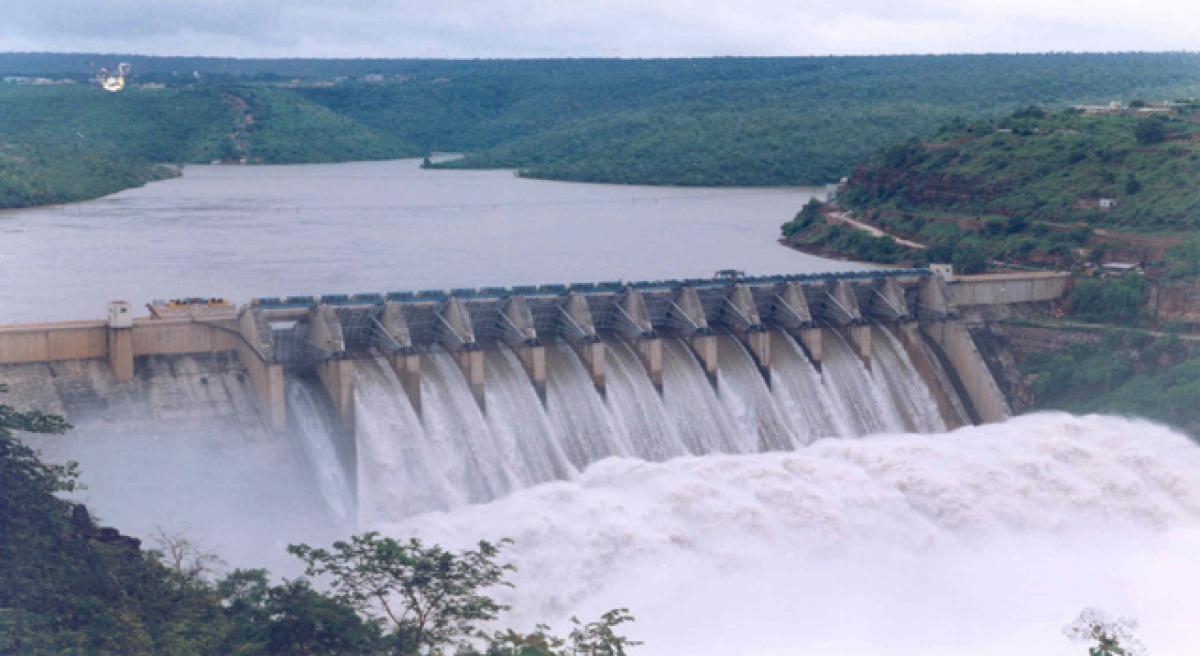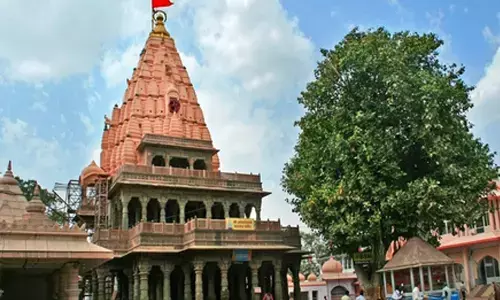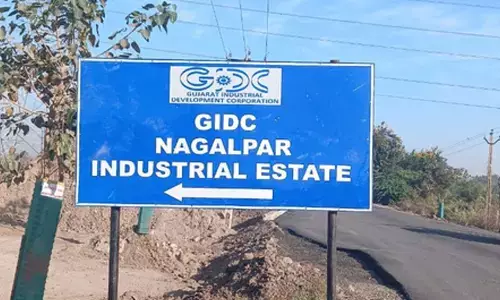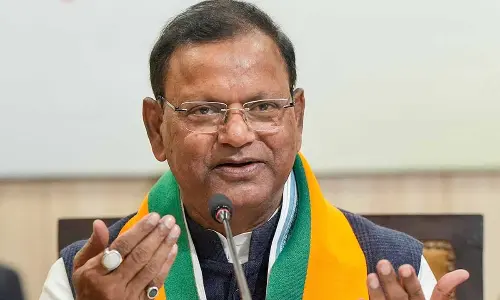Mighty flows the Krishna

This River tells ancient tales. Of lives spent on its banks. Of boats, that traversed its length. Of hills, that hugged it along the way. Of days and nights that played hide and seek with its gurgling waters.
This River tells ancient tales. Of lives spent on its banks. Of boats, that traversed its length. Of hills, that hugged it along the way. Of days and nights that played hide and seek with its gurgling waters.
This river carries within it a life replete with history. It embarks on a journey every new day, smoothing over rough rocks and plumbing new depths.
Every day! It opens its arms wide to receive every new rain. It plumbs new depths and goes quiet over dark mysteries. It nourishes, it feeds. It quenches thirst and it embraces its admirers with a flourish.
This river is Krishna, the dusky one. The dark one. The one who bears the name of the Lord. Of mischief, of mystery, of wisdom and romance.
It is fascinating to watch river Krishna on the map. The way the mighty river finds its way in twists and turns, charting its course towards the sea.
Interestingly, the river is born just a few kilometres away from the Arabian Sea but chooses to find communion with the Bay of Bengal, passing through three large states before forking into two and meeting the sea at two places.
It is the fourth largest river in India with 29 tributaries joining in at various places and has a massive catchment area of 2,58,945 km, irrigating almost 30 per cent of land in Telangana and Andhra Pradesh. It travels a length of about 1,400 km before joining the Bay of Bengal.
Born in the Western Ghats as a small flow of water, the river gains strength as it passes through Maharashtra and Karnataka, taking along rivers such as Koyna, Varna, Panchaganga, Doodhganga, Ghata Prabha, Mala Prabha.
“Rivers are the veins of civilisation. Their course leads to the emergence of habitations and cities and defines an entire lifestyle and culture. So it is with Krishna River.
Even as it unites people across four states as a provider, at each bank that it touches, the river witnesses an amazing diversity in language, lifestyle, food and fashion,” explains Dr SK Avadhanulu, a veteran riparian historian.
Before the river enters Telangana State, it takes in the Bhima River and crosses the boundary at Tangadi. With Tungabhadra adding to its volume near Alampur, and other small rivers such as Dindi, Musi, Palair, Munneru etc, it enters Andhra Pradesh and widens at Vijayawada.
“There is a characteristic relationship between people and rivers in India. Unlike in the west, where a flowing river is only an element of a visual landscape, we in India attach a greater meaning and significance.
We worship nature, and water is the essence of life,” says Vasanta Sobha, Conservation Architect and Urban-Regional Planner.
River bed civilisations have given rise to many historical and religious places along the banks and Krishna is a particularly rich river in those terms, she says.
Temples dot the course of the river in the two Telugu states. Prominent among them are the Sri Mallikarjuna Swamy Temple at Srisailam in Kurnool district, Sri Amareswara Swamy temple at Amaravati in Guntur district, Sri Durga Malleswara Swamy temple at Vijayawada in Krishna district, Sri Narasimha Swamy at Mattapalli and Sri Narasimha Swamy and Siva temples at Vadapalli in Nalgonda district and Sangameswara Swamy temple in Alampur in Kurnool.
As it nears towards the sea, the river forks into two with Sri Andhra Maha Vishnu temple at Srikakulam in Krishna district, Sri Durga Nageswara Swamy temple in Pedakallepalli and Sri Venugopala Swamy temple at Hamsala Deevi in Diviseema in Krishna district, where the river joins the sea.
“The series of steps down to the river is also a very scientific, architectural phenomenon. The ghats are not only built to adjust to the seasonal variations and accelerations in a river’s flow but also grant access to people to go touch the water.
Ghats are also, more or less, an Indian phenomenon and indicate our veneration and association with rivers and streams,” adds Vasanta Sobha.
“For life and death are one, even as the river and the sea are one,” Kahlil Gibran famously said. And the axiom is perhaps nowhere else truer than in India, where a river weaves its way around a person’s life and is a part of rites of passage in one form or the other.
The waters of the river are holy and are deemed the ultimate link between a departing soul and the other world. Dozens of rituals are performed in and around rivers, each one a defining part of the human life and death cycle.
And each of the ghats and places along the river Krishna caters to a designated ritual, either attached to a deity or to the death of an individual.
The worship happens in the form of Darshanam (viewing the river), Snanam (bathing in the river), Daanam (Charity on the occasion), Tarpanam (Water obeisance to the forefathers) and Samarpanam (puja to the river).
Krishna Pushkarams have found mention in Puranas and in mythology. It is said that when Pandavas lost the gamble with Duryodhana and had to retreat to the forest for 12 years, they were told to bathe in Krishna to be liberated from the remnants of the years they spent in the forest and then hiding.
‘Pushkaradyani Teerthaani Krishnaadya Saritastadhaa! Aagacchanthu mahaabhaage, Snaana Kaale Sadaa Mama’ is the reference from Mahabharata where the Pandavas are advised about Pushkara Snanam.
Brahma Vaivarta Puranam asserts that dipping in Krishna when Brihaspati enters Kanya Rashi gives results to the equivalence of donating a lakh cows and performing an Ashwamedha Yaga. Brahmanda Puranam also has similar prescriptions and assurances pertaining to Krishna Pushakarams.
Poets have waxed eloquent about Krishna too with Devulapalli Krishna Sastry calling it ‘Uttunga Bhanga Krishnaveni’, the one with rising and breaking waves.
The river, deceptively calm in offseason, becomes a flow of fury in monsoons, corroding the land that it traverses through even as it irrigates vast tracts of land and sustains lush vegetation.
Krishnaveni, as it is known in the Telugu states, has been given a feminine form in literature and poetry, with descriptions matching a dusky woman who roams the land with tinkling anklets.
Poet Sita Rambabu Chennuri finds a new viewpoint for the river. “Krishna flows eternally, thousands of years of journey. It hides centuries of history, filled in a tearful memory.
It taught culture to a man who returned the favour by breaking the river's flow. Projects are wounds on the river and our fights for water a tragedy for Krishna," he writes.
The river bows to the various deities on its way and beseeches the Gods to give Sanmati to the people. And then flows eagerly to meet its beloved and the occasional visitor Pushkar, imagines the poet.
At a more mundane level, the river has been a source of contention in water disputes between states and the many projects that are built over the river at various places such as Almatti, Nagarjuna Sagar, Srisailam, Jurala, Pulichintala, Prakasam have been tailored to share the waters.
It is said that Krishna is a particularly aggressive river and carries away mud from its areas of origin, making the delta area of 258,948 square kilometres one of the most fertile agricultural belts in the whole country.
From Mahabaleshwar, the river forms into a lake Dhom in Panchgani. It then traverses through Narsobachi, Wadi, Karnataka before entering Karnataka with tributaries in Bagalkot and Kalburgi districts and enters Telangana and then Andhra Pradesh, encompassing ancient Buddhist sites at Nagarjunakonda and Amaravati.
The river may very well have its origin in a different State but the Telugus have always found a sense of belonging and affinity for the river calling it the ‘Teluginti Viriboni’...a damsel of the Telugu land.
The way the river swings and wings its way through hills and plains has inspired artists and artistes and has been the fountainhead of many a legend.
We love our rivers. There is a whole gamut of emotions associated with our rivers, ranging from romance to devotion, from wonder to fear.
And from curiosity to reflection. We celebrate them and attribute a holiness to it that absolves not just us but forefathers of all sins.
We taste the waters with pleasure, bathe in the waters with relish and respectfully watch the ashes of our loved ones get carried away in the swirling waters.
And as the 2016 Pushkarams open, an entire generation of Telugus are introduced to that magnificent phenomenon called Krishna River, injecting them into the process with an ancient Indian ethos.
By: Usha Turaga-Revelli


















